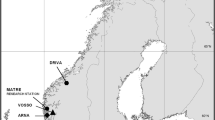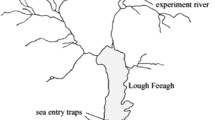Abstract
Epistasis among quantitative trait loci (QTL) for survival (upper thermal tolerance, UTT) and morphological (fork length, FL and condition factor, K) traits was detected in purestrain and interstrain rainbow trout (Oncorhynchus mykiss) families. One sex-linked (OmyFGT19TUF) and three autosomal (Omy325UoG, Ssa14DU and Ssa20.19NUIG; linkage groups B, D and S, respectively) microsatellite loci linked to UTT QTL in this species were used. Within half sib families, significant effects of full sib family on epistasis involving Omy325UoG and OmyFGT19TUF were detected at a rate significantly higher than expected for UTT (p < 0.001*) and FL (p < 0.01*), using results significant at comparisonwise significance thresholds derived from permutational analysis. Measured across half sib families, the phenotype of female genotypic classes was more divergent from the family trait mean than that of males where epistasis involved the sex-linked locus OmyFGT19TUF (p = 0.0176*), and also for means over all families (p = 0.0355*). Female genotypic classes were also more divergent (p = 0.0011**) from the full sib trait mean where three-way interaction between OmyFGT19TUF, one of the autosomal loci and full sib family was significant, and marginally more divergent for trait means of genotypic classes across all full sib families (p = 0.0856†). There was no evidence that these effects were more pronounced in hybrid F1 families than purestrains.
Similar content being viewed by others
References
Armbruster, P., W.E. Bradshaw, A.L. Steiner & C.M. Holzappel, 1999. Evolutionary responses to environmental stress by the pitcher-plant mosquito, Wyeomyia smithii. Heredity 83: 509–519.
Capel, B., 2000. The battle of the sexes. Mech. Devel. 92: 89–103.
Charlesworth, B., 2001. Genome analysis: more Drosophila Y chromosome genes. Curr. Biol. 11: R182–R184.
Cheverud, J.M. & E.J. Routman, 1995. Epistasis and its contributions to genetic variance components. Genetics 139: 1455–1461.
Cheverud, J.M., T.T. Vaughn, L.S. Pletscher, A.C. Peripato, E.S. Adams, C.F. Erikson & K.J. King-Ellison, 2001. Genetic architecture of adiposity in the cross of LG/J and SM/J inbred mice. Mamm. Genome 12: 3–12.
Churchill, G.A. & R.W. Doerge, 1994. Empirical threshold values for quantitative trait mapping. Genetics 138: 963–971.
Colihueque, N., P. Iturra, F. Estay & N.F. Diaz, 2001. Diploid chromosome number variations and sex chromosome polymorphism in five cultured strains of rainbow trout (Oncorhynchus mykiss). Aquaculture 198: 63–77.
Coyne, J.A., N.H. Barton & M. Turelli, 2000. Is Wright's shifting balance process important in evolution? Evolution 54: 306–317.
Cruzan, M.B. & M.L. Arnold, 1999. Consequences of cytonuclear epistasis and assortative mating for the genetic structure of hybrid populations. Heredity 82: 36–45.
Danzmann, R.G., T.R. Jackson & M.M. Ferguson, 1999. Epistasis in allelic expression at upper temperature tolerance QTL in rainbow trout. Aquaculture 173: 45–58.
Davis, G.H., K.G. Dodds, R. Wheeler & N.P. Jay, 2001. Evidence that an imprinted gene on the X chromosome increases ovulation rate in sheep. Biol. Reprod. 64: 216–221.
Falconer, D.S. & T.F.C. Mackay, 1996. Introduction to Quantitative Genetics, 4th edn. Longman Science and Technology, Harlow, UK.
Fenster, C.B. & L.F. Galloway, 2000. The contribution of epistasis to the evolution of natural populations: a case study of an annual plant, pp. 232–244 in Epistasis and the Evolutionary Process, edited by J.B. Wolf, E.D. Brodie III & M.J. Wade. Oxford University Press, Toronto.
Fleming, I.A. & M.R. Gross, 1994. Breeding competition in a Pacific salmon (Coho: Oncorhynchus kisutch): measures of natural and sexual selection. Evolution 48: 637–657.
Frankel, W.N. & N.J. Schork, 1996. Who's afraid of epistasis? Nat. Genet. 14: 371–373.
Gharbi, K., 2001. Construction of a genetic linkage map in the tetraploid derivative brown trout (Salmo trutta): comparative mapping of paralogous regions, map alignment with orthologous segments in rainbow trout (Oncorhynchus mykiss) and Atlantic salmon (Salmo salar). PhD Thesis, Institut National Agronomique Paris-Grignon, Paris (in French).
Goodnight, C.J. & M.J. Wade, 2000. The ongoing synthesis: a reply to Coyne, Barton, and Turelli. Evolution 54: 317–324.
Gross, M.R., 1996. Alternative reproductive strategies and tactics: diversity within sexes. Trends Ecol. Evol. 11: 92–98.
Gurganus, M.C., S.V. Nuzhdin & J.W. Leips, 1999. High-resolution mapping of quantitative trait loci for sternopleural bristle number in Drosophila melanogaster. Genetics 152: 1585–1604.
Hartley, S.E., 1987. The chromosomes of salmonid fishes. Biol. Rev. 62: 197–214.
Jackson, T.R., M.M. Ferguson, R.G. Danzmann, A.G. Fishback, P.E. Ihssen, M. O'Connell & T.J. Crease, 1998. Identification of two QTL influencing upper temperature tolerance in rainbow trout (Oncorhynchus mykiss). Heredity 80: 143–151.
Jobling, M.A., G. Williams, K. Schiebel, A. Pandya, K. McElreavey, L. Salas, G.A. Rappold, N.A. Affara & C. Tyler-Smith, 2001. A selective difference between human Y-chromosomal DNA haplotypes. Curr. Biol. 8: 1391–1394.
Johnson, K.R., J.E. Wright Jr. & B. May, 1987. Linkage relationships reflecting ancestral tetraploidy in salmonid fish. Genetics 116: 579–591.
Johnson, N.A., D.E. Perez, L. Cabot, H. Hollocher & C.I. Wu, 1992. A test of reciprocal X-Y interactions as a cause of hybrid sterility in Drosophila. Nature 358: 751–753.
Liu, X., L. Bünger & P.D. Keightley, 2001. Characterization of a major X-linked quantitative trait locus influencing body weight of mice. J. Hered. 92: 355–357.
Lynch, M., 1991. The genetic interpretation of inbreeding depression and outbreeding depression. Evolution 45: 622–629.
Lynch, M. & A. Force, 2000. The probability of duplicate gene preservation by subfunctionalization. Genetics 154: 459–473.
Orr, H.A. & S. Irving, 2001. Complex epistasis and the genetic basis of hybrid sterility in the Drosophila pseudoobscura Bogota-USA hybridization. Genetics 58: 1089–1100.
Otto, S.P. & M.W. Feldman, 1997. Deleterious mutations, variable epistatic interactions, and the evolution of recombination. Theor. Popul. Biol. 51: 529–545.
Perry, G.M.L., 2001. The genetic architecture of thermal tolerance and growth-related traits in rainbow trout, Oncorhynchus mykiss. PhD Thesis, University of Guelph, Guelph, Canada, 259 pp.
Perry, G.M.L., R.G. Danzmann, M.M. Ferguson & J.P. Gibson, 2001. Quantitative trait loci for upper thermal tolerance in outbred strains of rainbow trout. Heredity 86: 333–341.
Phillips, P.C., S.P. Otto & M.C. Whitlock, 2000. Beyond the average: the evolutionary importance of gene interactions and variability of epistatic effects, pp. 20–38 in Epistasis and the Evolutionary Process, edited by J.B. Wolf, E.D. Brodie III & M.J. Wade. Oxford University Press, Toronto.
Pottinger, T.G. & T.R. Carrick, 2000. Contrasting seasonal modulation of the stress response in male and female rainbow trout. J. Fish Biol. 56: 667–675.
Rand, D.M., A.G. Clark & L.M. Kann, 2001. Sexually antagonistic cytonuclear fitness interactions in Drosophila melanogaster. Genetics 159: 173–187.
Rikardsen, A.H., M.-A. Svenning & A. Klemetsen, 1997. The relationship between anadromy, sex ratio and parr growth of Arctic charr in a lake in North Norway. J. Fish Biol. 51: 447–461.
Rohrer, G.A. & J.W. Keele, 1998a. Identification of quantitative trait loci affecting carcass composition in swine. I. Fat deposition traits. J. Anim. Sci. 76: 2247–2254.
Rohrer, G.A. & J.W. Keele, 1998b. Identification of quantitative trait loci affecting carcass composition in swine. II. Muscling and wholesale product yield traits. J. Anim. Sci. 76: 2255–2262.
Routman, E.J. & J.M. Cheverud, 1997. Gene effects on a quantitative trait: two-locus epistatic effects measured at microsatellite markers and at estimated QTL. Evolution 51: 1654–1662.
Sakamoto, T., R.G. Danzmann, K. Gharbi, A. Ozaki, K. Sokkean, R.A. Woram, N. Okamoto, M.M. Ferguson, L.-E. Holm, R. Guyomard & B. Hoyheim, 2000. A microsatellite linkage map of rainbow trout (Oncorhynchus mykiss) characterized by large sex-specific differences in recombination rates. Genetics 155: 1331–1445.
Statistical Analysis Software (SAS) Institute, 1999. SAS version 8.02. SAS Institute Inc., Cary, NC.
Templeton, A.R., 2000. Epistasis and complex traits, pp. 41–57 in Epistasis and the Evolutionary Process, edited by J.B. Wolf, E.D. Brodie III & M.J. Wade. Oxford University Press, Toronto.
Thorgaard, G.H., 1983. Chromosomal differences among rainbow trout populations. Copeia 1983: 650–662.
Whitlock, M.C., P.C. Phillips, F.B.G. Moore & S.J. Tonsor, 1995. Multiple fitness peaks and epistasis. Annu. Rev. Ecol. Syst. 26: 601–629.
Willett, C.S. & R.S. Burton, 2001. Viability of cytochrome C genotypes depends on cytoplasmic backgrounds in Tigriopus californicus. Evolution 55: 1592–1599.
Wright, J.E. Jr., K.R. Johnson, A. Hollister & B. May, 1983. Meiotic models to explain classical linkage, pseudolinkage, and chromosome pairing in tetraploid derivative chromosome pairing in tetraploid derivative salmonid genomes. Isozymes Curr. Top. Biol. Med. Res. 10: 239–260.
Wright, S., 1932. The roles of mutation, inbreeeding, cross breeding and selection in evolution. Proc. Sixth Internat. Congress Genet. 1: 356–366.
Author information
Authors and Affiliations
Rights and permissions
About this article
Cite this article
Perry, G., Ferguson, M. & Danzmann, R. Effects of Genetic Sex and Genomic Background on Epistasis in Rainbow Trout (Oncorhynchus mykiss). Genetica 119, 35–50 (2003). https://doi.org/10.1023/A:1024493013926
Issue Date:
DOI: https://doi.org/10.1023/A:1024493013926




